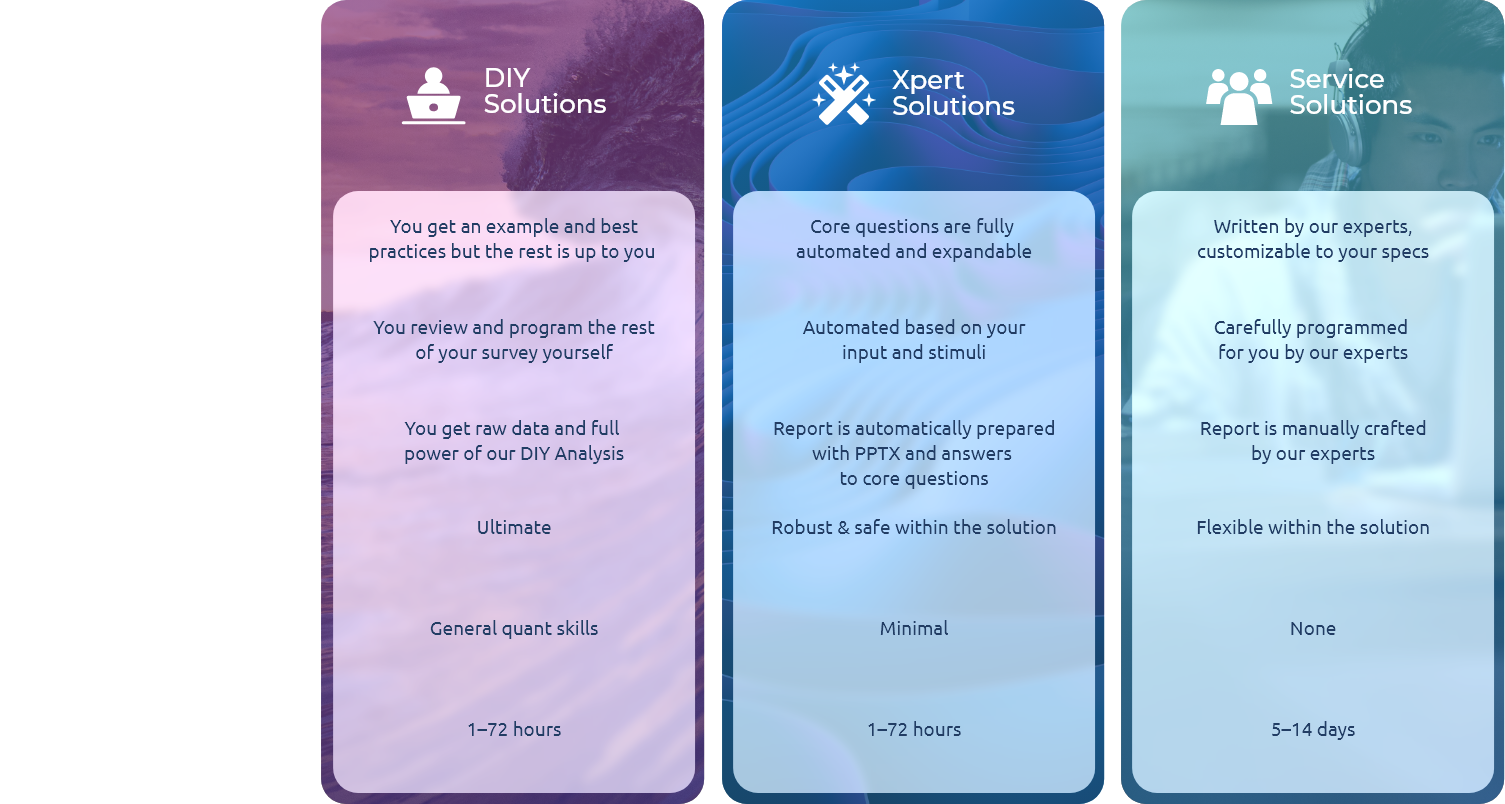Solutions Center



Want to easily analyze between 2–100 ad creative images and determine the best-performing ad? This sequential monadic designed survey allows you to collect feedback and explore reactions on attributes like appeal, clarity, and relevance, to your own custom attributes.
Learn how to leverage this solution to understand and evaluate your next round of advertising creative.
Expand the utility of your MaxDiff exercise by conducting an Anchored MaxDiff. This flavor of MaxDiff allows a researcher to not only assess the relative importance or appeal of a large number of items, but also to determine a utility boundary—that is, a threshold by which to judge which items actually have a positive impact or not.
This powerful tool helps you understand the types of decisions consumers make when forced to make trade-offs between different features or elements of products, services, and offerings.
Find out which elements drive most decisions and explore how your preference share shifts when you change an element.
Need to compare six different ad creatives to determine which will be the most impactful to your audience? Utilize a sequential monadic method to discover which ad creative is the favorite among respondents.
Learn more about how this Xpert Solution can determine which ad creative is best received.
Need to compare six different ad creatives to determine which will be the most impactful to your audience? Utilize a sequential monadic method to discover which ad creative is the favorite among respondents.
Learn more about how this Xpert Solution can determine which ad creative is best received.
Our powerful perceptual mapping tool helps you understand the relative similarities and differences between your brand and others.
These dynamic perceptual map and interactive topography visualizations help uncover powerful insights about how your brand stacks up to others.
Want to test and confirm the potential of up to 100 product or service concepts? This solution helps you determine which concepts are most likely to get people interested in purchasing and which concepts might be more attractive to respondents.
Select a monadic or sequential monadic survey design and explore what makes your concepts appealing by their custom attributes and perceived value.
Want to test and confirm the potential of up to 100 product or service concepts? This solution helps you determine which concepts are most likely to get people interested in purchasing and which concepts might be more attractive to respondents.
Select a monadic or sequential monadic survey design and explore what makes your concepts appealing by their custom attributes and perceived value.
Have advertising images and need to know which will pack the most punch to your audience? Evaluate up to 10 advertising images using a monadic design research method to quickly measure reactions, compare ratings, and confidently choose the best materials for your campaign.
Learn more about how this Xpert Solution provides you with everything needed to make a quick and effective decision.
Have advertising images and need to know which will pack the most punch to your audience? Evaluate up to 10 advertising videos using a monadic design research method to quickly measure reactions, compare ratings, and confidently choose the best materials for your campaign.
Learn more about how this Xpert Solution provides you with everything needed to make a quick and effective decision.
Get detailed feedback regarding which elements really stand out about your product or upcoming advertisement with this heatmap tool.
Respondents interact with a concept that can include images and text by placing pins to indicate areas areas they like, don't like, or any sentiment you wish to ask. Use the heatmap to discover the most concentrated areas, and be able to optimize your concept accordingly.
Want to learn whether or not people's implicit feelings about your product have a stronger influence on whether they purchase? This Xpert Solution pits the traditional explicit ratings of products against respondents' implicit ratings, allowing you to see what truly† drives purchase intent.
Need to know if your ad communicates a persuasive message that gets the viewer's conscious attention? Want to understand how the consumer perceives your video in real time?
Impression Dial is designed to track a range of respondent feelings throughout the viewing process in order to assure attentiveness and accuracy as you record how respondents react to your videos.
Learn more about how this Xpert Solution provides you with everything needed to make a quick and effective decision.
MaxDiff is a great way to compare many alternatives without overwhelming respondents by asking them to read and consider all items at once.
This tried and true approach efficiently asks respondents to compare a handful of smaller sets of items and compiles the results to estimate the preference likelihood for all items.
Looking to find the best price for your product and optimize your profits? This Xpert Solution lets you test your product at 4–10 different price points. Refine your results through this monadic design by determining purchase frequency as well—it even lets you add concept testing attributes to better understand consumer pricing opinions.
Learn more about how this Xpert solution provides you with everything needed to make a quick and effective decision.
Do you need to decide which marketing messages are most appealing to your consumers? This Xpert Solution lets you test up to 80 different product claims using a MaxDiff exercise and come to a data-driven conclusion. At the end of the exercise, you’ll be able to download TURF analysis to figure out which combinations of messages can reach the most people effectively.
Get gut reactions to products or advertisements by tapping into System 1 thinking--thinking that is fast, uncontrolled, and automatic. The Rapid Association tool can increase your confidence that you are tapping into these intuitive decisions, unmarred by System 2 thinking--the more considered thinking that might not represent real in-the-moment choices.
Quantify consumer purchase behavior with aytm's agile Shelf Test. Gather real-time automated insights to inform shelf placement, fine-tune packaging concepts, and deepen your overall understanding of the shopping journey.
Analyze what respondents purchase, click on, how long it takes to find a product, and much more.
Side-by-Side is a more tenable way for respondents to shift through choices than a traditional rank-order exercise while allowing you to obtain the same order preference information.
Respondents focus on pairs of items, only needing to decide the better of the two. This can often be more straightforward than when respondents must consider and sort all items simultaneously.
Van Konan extends beyond the price sensitivity curves of Van Westendorp to incorporate vital context, such as likelihood of purchase, frequency of purchase, and total addressable market, to identify the optimal price points for max revenue and max profits.

